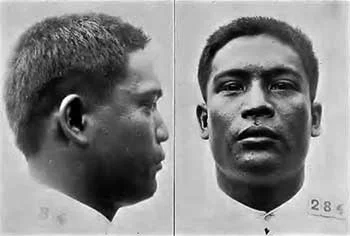Photos of “Typical” Batangas Tagalogs in 1904 according to an Expo Board Publication
In 1904, a world exposition was held from April to December in the Missouri City of St. Louis. It was called the Louisiana Purchase Exposition or, more popularly, the St. Louis World Fair. A total of 60 countries and some 45 American states kept exhibition areas which focused on diverse themes such as technology, history, architecture and anthropology1
The Philippines participated in the exposition, of course as a newly-acquired American colony. Because Anthropology was among the themes of the exposition, the American organizers brought over to St. Louis tribal people from the Mountain Province who were then described as “primitive2.”
This was something that many nationalists and intellectuals back in the country did not find amusing since the move was construed as a deliberate attempt to portray the Filipinos as backward, notwithstanding the fact that there were many among them who were even European-educated.
Perhaps just as offensive was a 1904 publication3 presumably intended for distribution during the World Fair, which showed pictures in an album of “typical” Filipino men as sampled from inmates of the Bilibid prison. On the face of things, the album appears to have presented Filipinos as though a Biology book would simian species.
To put matters in perspective, however, this was an era when the American public was hungry for information about their newly-acquired colony; and suffice it to say that there was a fair amount of opposition to the annexation even among Americans. Portraying Filipinos as backward at the fair was, perhaps, part of an attempt by the American leadership to justify to its own public its “benevolent acquisition and rule” over the Philippines.
Why prisoners were selected as representatives of average Filipino “provincial types” was probably a matter of convenience, since the men were incarcerated and easy to study. The averages would have been reasonably accurate since they were of physical rather than behavioral attributes. Standard deviations would have been useful, albeit not provided.
The publication itself described the selection process for inclusion in the album:
First, all the men available from a given province, in some cases over one hundred, were lined up by height, and from twenty to fifty, where possible, these being of all heights, were taken for measurements. Secondly, from the ranks of these chosen men a selection was made by intervals for photographs and for more minute study; the resulting list was thus fairly representative of the chief physical types; if any were manifestly abnormal they were rejected. Thirdly, from the large number of photographs thus obtained for the exhibit, fifteen or twenty in the case of some provinces, it was aimed to select two of the best for the Album. As will be seen from the record of measurements printed opposite each photograph, the men selected were generally those nearest the average of their province, although this was impossible in some cases.
| CATEGORY | 28 Batangas Tagalogs | 169 Tagalogs from 7 Provinces |
| Height in meters (converted) | 1.611 (5.285 ft) | 1.596 (5.236 ft) |
| Span of arms in meters (converted) | 1.668 (5.472 ft) | 1.563 (5.127 ft) |
| Width of shoulders in meters (converted) | 0.425 (1.394 ft) | 0.420 (1.378 ft) |
| Length of head in meters (converted) | 0.183 (0.600 ft) | 0.180 (0.591 ft) |
| Breadth of head in meters (converted) | 0.152 (0.497 ft) | 0.150 (0.492 ft) |
| Height of nose in meters (converted) | 0.052 (0.171 ft) | 0.051 (0.167 ft) |
| Breadth of nose in meters (converted) | 0.041 (0.135 ft) | 0.041 (0.135 ft) |
| Chest in meters (converted) | 0.887 (2.910 ft) | 0.875 (2.871 ft) |
| Weight in kilos (converted) | 54.860 (120.946 lbs) | 53.190 (117.264 lbs) |
| Cephalic index4 in percentage | 82.040 | 83.090 |
| Nasal index5 in percentage | 79.71 | 79.69 |
The top photo, labeled as Plate 39 in the publication, shows a sample of a man from Batangas with measurements slightly above the provincial averages for Batangas, with the height of 1.718 meters; span of arms of 1.743 meters; width of shoulders of 0.439 meters; length of head of 0.183 meters; breadth of head of 0.159 meters; height of nose of 0.053 meters; breadth of nose of 0.041 meters; chest of 0.908 meters; weight of 66 kilos; cephalic index of 86.89%; and nasal index of 77.36%.
Below, meanwhile, is a sample of a man from Batangas with measurements slightly lesser than the provincial averages for Batangas. The picture is labeled Plate 40 in the publication. The man’s dimensions are: height of 1.460 meters; span of arms of 1.500 meters; width of shoulders of 0.398 meters; length of head of 0.175 meters; breadth of head of 0.142 meters; height of nose of 0.050 meters; breadth of nose of 0.038 meters; chest of 0.830 meters; weight of 42.18 kilos; cephalic index of 81.13%; and nasal index of 76%.
2 Wikipedia, ibid.
3 “Album of Philippine Types: Christians and Moros,” by Daniel Folkmar, published 1904.
4 Cephalic index is ‘a number expressing the ratio of the maximum breadth of a skull to its maximum length.’ >Wikipedia.
5 Nasal index is the ratio of nasal breath (or width) to length. Human Phenotypes


